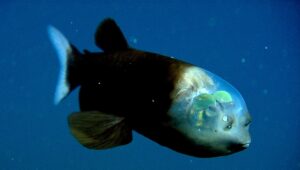In 1938, off the coast of Africa, a lucky fisherman stumbled upon an extraordinary discovery: the Latimeria fish, thought to have been extinct for a staggering 66 million years, and its oldest fossils reach to 420 000 000 years. This unusual creature, which lives at a depth of up to 700 meters, boasts scales that act as protective armor and a characteristic intracranial joint that allows the mouth to expand. Notably, the Latimeria fish has a specialized adipose lung, a common adaptation among deep-sea dwellers that helps regulate buoyancy. Their diet consists mainly of smaller fish and cephalopods.
Their habitat includes the eastern coast of Africa, the southern tip of Madagascar and the waters surrounding Indonesia. They take advantage of the ups and downs of strong sea currents, stabilizing themselves with their fins. When they are on the seafloor they don’t use any fins except caudal fin.
In the presence of potential predators, such as submarines, Latimeria fish show a pronounced reaction, quickly fleeing in panic, suggesting that they may be prey to larger deep-sea predators. However, interactions with conspecifics do not produce any distress signals, indicating a relaxed attitude among their own species. Despite the apparent comfort of deep caves, physical contact causes immediate withdraw. It would be a shame to lose fish as old as this one.



